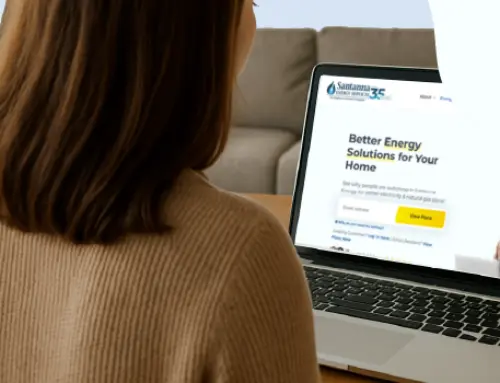10 Things to Do After Your Offer Is Accepted — Including Setting Up Utilities
by Jenna Mendez
15.9 min read

Having your offer accepted is an exciting milestone. Congratulations! But it’s important to understand that it’s not the finish line. From the moment the seller says “yes” until the day you get the keys, there’s a series of important steps that protect your investment, keep your financing on track, and make sure your new home is ready for move-in.
Knowing exactly what happens after your offer is accepted and when to take action can save you from costly delays, unexpected bills, or last-minute stress on closing day. As an energy supplier with 35 years of experience, we’ve helped thousands of customers navigate their new home’s energy journey.
In this guide, we’ll walk you through the 10 most important things to do after your offer is accepted, from coordinating with your real estate team to making sure the lights (and heat) are on when you move in.
Key Points of This Article:
- After your offer is accepted, you’re officially “under contract,” but you still need to complete key steps like inspections, appraisals, and final loan approval before closing.
- It’s crucial to act quickly—schedule your home inspection, pay earnest money, and send all required documents to your lender to avoid delays or risking the deal.
- Setting up utilities early ensures your new home has electricity, gas, water, and internet on move-in day, and helps prevent double billing or service gaps.
- Before closing, review your Closing Disclosure, do a final walkthrough to confirm repairs, and secure homeowners insurance to protect your investment from day one.
What Does It Mean When Your Offer is Accepted on a House?
When your offer is accepted, it’s an exciting milestone where you and the seller have agreed on the price and terms, and you’ve both signed a purchase agreement. This is just the beginning of the final stretch, not the finish line.
At this stage, you’re considered “under contract,” and the home is usually taken off the market so no one else can make an offer. Still, the sale isn’t official yet because there are important steps to work through, like the home inspection, appraisal, final loan approval, and getting your homeowners’ insurance in place.
According to Zillow, this process typically takes 30 to 45 days. During this period, contingencies come into play. These are conditions built into the contract that protect you as the buyer, ensuring the property is in good shape and that your financing is secure.
During this time, the key is to stay on top of deadlines and be proactive with your lender and agent, so nothing slips through the cracks. In short, having your offer accepted is a huge step forward, but it’s also the start of the due diligence phase that gets you closer to holding the keys in your hand.
Signs Your Offer Will Be Accepted on a House
While nothing is certain until the contract is signed, there are a few encouraging clues that a seller is leaning toward saying “yes.” Check out these signs that your offer will be accepted on a house:
- Good feedback on your offer – If the seller or their agent says things like, “Your offer looks fair,” or “We’re happy with the terms,” that’s a strong sign your offer will be accepted.
- A quick response – Hearing back within a day or two shows the seller is actively considering your offer. Even if they come back with a counteroffer, it means you’re still in the running.
- Request for a pre-approval letter – If they ask to see proof of financing, it usually means they’re checking to make sure you can close the deal and are seriously considering moving forward.
- Willingness to negotiate – A counteroffer, instead of a flat-out “no,” is a sign the seller wants to work with you to find common ground on price or terms.
- Clear and open communication – When the seller is responsive and upfront about what they want, it often means they’re engaged in the process and motivated to get to an agreement.
- Formal acknowledgement of your offer – If the seller signs to confirm they’ve received your offer, it’s a step closer to acceptance.
Spotting these signs early can help you prepare for the next steps so you’re ready to move quickly if the seller says “yes.”
What Happens After Your Offer is Accepted on a House? 10 Things to Do Once Your Offer is Accepted
Once a seller accepts your offer, the clock starts ticking. There’s a lot to get done before you can move in, and missing steps can cause costly delays or put your purchase at risk. But don’t worry, we’re here to help! Here’s a clear breakdown of what happens after your offer is accepted on a house and how to handle each stage so you’re ready to get the keys on closing day:
-
Connect With Your Real Estate Team
Once your offer is accepted, the first thing to do is check in with your real estate agent, lender, and closing attorney or title company. They’ll help you keep track of deadlines, arrange inspections, and handle the necessary paperwork.
This is important because real estate contracts have strict timelines for things like inspections, financing approval, and closing. Missing one of these dates could delay your closing or even put your purchase at risk.
To stay on top of things, decide how you’ll communicate with your team, whether that’s through phone calls, texts, or email, and keep all your paperwork in one place so it’s easy to find when you need it.
-
Schedule a Home Inspection
An inspection is your chance to have a professional evaluate the property’s condition, from the roof to the foundation, including the plumbing and electrical systems.
It’s best to schedule the inspection as soon as possible after your offer is accepted, as your contract may limit how long you have to complete it. If you can, attend the inspection in person so you can ask questions and learn about the home’s maintenance needs directly from the inspector.
-
Pay Your Earnest Money (and Any Due Diligence Fee)
Earnest money is a deposit, usually 1–3% of the purchase price, that shows the seller you’re serious about buying the home.
These funds are typically due within a few days of your offer being accepted and are held in escrow (a neutral third-party account that safely holds money until the transaction is complete) until closing, when they’re applied to your down payment or closing costs.
Always verify wiring instructions by calling your title company or attorney directly, as wire fraud is a growing risk in real estate transactions.
-
Send Your Lender All Requested Documents Quickly
Your lender can’t finalize your mortgage until they’ve reviewed your financial documents, which may include pay stubs, W-2s, tax returns, and bank statements. Sending these promptly allows your lender to move forward with ordering an appraisal.
Delaying this step is one of the most common reasons closings get pushed back. During this time, avoid making large purchases, opening new credit accounts, or changing jobs, as these can affect your loan approval. Think of this step as “showing the bank you’re ready, willing, and able” to afford the home you’re buying.
-
Set a Closing Date With Your Attorney or Settlement Agent
Your closing date is the day ownership officially transfers from the seller to you. Closing dates are usually set 30–60 days after your offer is accepted. Depending on where you live, closings are handled either by a real estate attorney or a title/escrow company. It’s important to confirm this date early so all parties can work toward the same deadline.
According to the Consumer Financial Protection Bureau, your lender must provide you with a Closing Disclosure at least three business days before your scheduled closing. This document lists your final loan terms, interest rate, monthly payment, and all closing costs. Use those three days to review everything carefully and ask questions if something doesn’t look right.
-
Complete the Home Appraisal
Your lender orders the appraisal to ensure the home’s market value matches (or exceeds) the purchase price. This protects both you and the lender from overpaying.
If the appraisal comes back lower than the agreed price, you may need to renegotiate with the seller, pay the difference out of pocket, or use your appraisal contingency to cancel the deal.
You are entitled to receive a copy of the appraisal report promptly once it’s complete, and by law, no later than three business days before closing. Keeping your agent informed during this stage can help ensure the appraiser has access to relevant comparable sales that support your purchase price.
-
Negotiate Repairs or Credits
If your inspection reveals issues, you can submit a repair request to the seller. This might involve asking them to fix the problem before closing, lower the purchase price, or provide a credit toward your closing costs so you can handle the repairs yourself.
It’s wise to focus on major safety, structural, or system-related issues, rather than cosmetic imperfections. Sellers aren’t obligated to agree to your requests, but in many cases, they’re willing to work with you to keep the sale moving forward.
This stage is important because it’s often your last chance to address significant issues before you own the home.
-
Secure Homeowners Insurance
Your lender will not allow the closing to proceed until they receive proof of homeowners insurance. This coverage protects your investment from risks like fire, theft, or storm damage from the moment you take ownership.
Shopping for insurance early can save you money and give you time to compare coverage options. Make sure your policy is set to start on your closing or move-in date and covers the full replacement cost of the home. Depending on your location, you may want to add extra coverage for things like flooding, earthquakes, or power surges.
-
Set Up Utilities
Before your closing, contact the electric, gas, water, and internet providers to transfer service into your name starting on your closing or possession date.
In deregulated states such as Pennsylvania, Illinois, and Ohio, you can choose your energy supplier, which may give you access to better rates or diverse energy plan options. Keep in mind that you can’t enroll until you have received your Utility Account Number from your utility company; however, you can still research your options while your offer is being accepted.
Be sure to request a final meter reading at your current address and an opening reading at your new home to prevent double -billing. Utilities are easy to overlook, but they’re critical; no one wants to move into a cold, dark house.
-
Do Your Final Walkthrough and Close
The final walkthrough is your chance to make sure the home is in the condition you agreed to buy it in and that any agreed-upon repairs have been completed.
Bring a copy of your purchase agreement and inspection report to compare against. Test major systems and appliances, check for new damage, and take photos of the electric, gas, and water meters.
Once you’re satisfied, you’ll head to closing to sign the final documents, pay any remaining funds, and officially become the owner! This is the last and most rewarding step. We’re proud of you, you did it!
Can You Back Out of a House Offer?
So, can you back out of a house offer once it’s been accepted? The short answer is yes, you can, but whether you can do it without losing money depends on your contract and the reason you’re backing out.
Most purchase agreements include “contingencies,” which are protections that let you cancel the deal if certain things don’t go as planned, like the home failing inspection, the appraisal coming in too low, your financing falling through, or your current home not selling in time.
If you cancel for a reason covered by a contingency and within the set deadlines, you’ll usually get your earnest money deposit back. However, if you back out for reasons not specified in the contract, such as changing your mind or finding another home, you risk losing that deposit and possibly facing other consequences.
The key is to read your contract carefully, know your deadlines, and work with your agent or attorney to follow the correct process if you decide not to move forward.
When Can You Move In After Your Offer Is Accepted?
Your move-in timing depends on a few factors, like what you and the seller agreed to in the contract, whether the home is already empty, and whether it’s a brand-new build or an existing home. In many situations, if the seller has already moved out and everything goes smoothly, you can get the keys and move in the same day you close.
On the other hand, some contracts include a rent-back period, giving the seller extra time to stay in the home, or there could be delays that push back possession. The best way to avoid last-minute surprises is to go over the move-in details with your agent or attorney well before closing day.
How to Set Up Utilities After Acceptance of the House
Once your offer is accepted, you can (and should) start planning your utility setup right away. This step ensures that your new home has working electricity, gas, water, and internet the day you move in, and it helps you avoid last-minute stress, extra costs, or service gaps. Here’s how to set up your utilities after your offer on the house has been accepted:
- Make a utility list for your new home: Ask your real estate agent or the seller for a list of current utility providers, including electric, gas, water/sewer, trash, and possibly internet or cable. This saves you time researching who serves your new address.
- Contact companies early: Reach out to each utility company at least 1–2 weeks before closing to schedule service to start on your closing or possession day. If the home is already vacant, some buyers even choose to start service a day or two early to ensure everything works before moving in.
- Know your market type: regulated or deregulated: In deregulated states, you can choose your electricity or gas supplier for the supply portion of your bill. Energy deregulation often gives you more flexibility in plan options than you would have if you stayed with your main utility. Be sure to explore all your options before you lock in your electricity and natural gas provider. In regulated markets, you unfortunately won’t have the option to choose an energy supplier, so you’ll work directly with the local utility for both delivery and supply.
- Confirm connection requirements: Some services (especially gas and water) may require a technician to visit your property to turn service on. Plan to be there, or have someone you trust on-site, so the appointment doesn’t get rescheduled.
- Document your start readings: On your move-in day, take clear photos of your electric, gas, and water meters. This protects you from being charged for usage before you took possession.
How to Avoid Utility Double Billing and Service Gaps During a Move
When you’re moving, it’s easy to focus on boxes and moving trucks—but forgetting to coordinate your utility shut-offs and start dates can lead to two costly problems:
- Double billing occurs when you pay utility bills for both your old home and your new home simultaneously.
- Service gap occurs when you move into a home without power, heat, or water.
Both are avoidable with a little planning. Here’s how you can avoid them:
How to Prevent Double Billing During a Move:
- Schedule a final meter reading at your current address for the day you move out. Ask your utility to send you a final bill and close the account on that date.
- Take meter photos on your move-out day as proof of your final reading—this can protect you if there’s a billing dispute later.
- Notify your landlord or buyer (if selling) that utilities will be disconnected or transferred so they can arrange their own service setup.
How to Prevent Service Gaps:
- Contact the utility company for your new home early, ideally 2–3 weeks before moving, to set the account start date for your closing or possession day.
- Confirm connection requirements. Some services, like natural gas or water, may require someone to be home for the technician to turn them on.
- If you’re in a deregulated energy market, you can enroll with an electricity or gas supplier once you have your Utility Account Number.
Coordinating your utility start and stop dates is just as important as planning your move. A quick call to both your current and future utility providers—plus taking a few photos of your meters—can save you money, prevent disputes, and ensure your new home is ready from day one.
FAQs
When should I set up electricity and gas—before or after closing?
Set up your accounts before closing, ideally 2–3 weeks in advance, with the start date scheduled for your closing or possession day. This ensures the lights and AC or heat are on when you move in and helps avoid service gaps.
Do I need to be home for a utility turn-on?
It depends on the service. For electricity in most areas, no one needs to be home. For natural gas and some water services, utilities often require someone to be present to allow the technician access and ensure appliances are safely lit.
Who pays utilities during a rent-back?
In a rent-back agreement, the seller (now tenant) typically continues to pay utilities until they move out, but the exact terms should be stated in the rent-back clause of your contract.
Does “under contract” mean sold?
No. “Under contract” means the seller has accepted an offer and both parties have signed the purchase agreement, but the sale hasn’t closed yet. The deal is still subject to contingencies like inspection, appraisal, and financing.
Conclusion
Moving from offer acceptance to move-in day is an exciting journey, but it’s also a busy one. By staying organized, meeting deadlines, and taking care of details like inspections, financing, and utility setup ahead of time, you can make your transition into your new home smooth and stress-free.
And once you’re settled in, keeping your home comfortable shouldn’t mean worrying about spikes in your energy supply charge. With Santanna’s Unlimited Energy plan, you get a predictable supply charge every month—no matter how much energy you use*—so you can enjoy peace of mind and budget certainty all year round.
Whether it’s heating in the winter or cooling in the summer, your supply charge stays the same, giving you one less thing to think about as you settle into your new home.
* Restrictions apply. Enrollment based upon program eligibility. Customers using more than 125% of normal monthly usage as determined by Santanna may be required to switch plans.
Jenna Mendez is a Midwest native with lifelong roots in Illinois and time spent in Ohio during college, giving her a deep understanding of the Midwest region’s people, climate, and energy needs. She brings firsthand experience and local insight to topics that matter to Midwest homeowners, especially energy efficiency, sustainability, and home living. Jenna specializes in writing about eco-friendly living, all things Midwest, renewable energy, and practical ways to reduce energy costs. Jenna brings a trusted, and local hometown voice to every article she writes, helping readers live well, and sustainably, right where they are.







